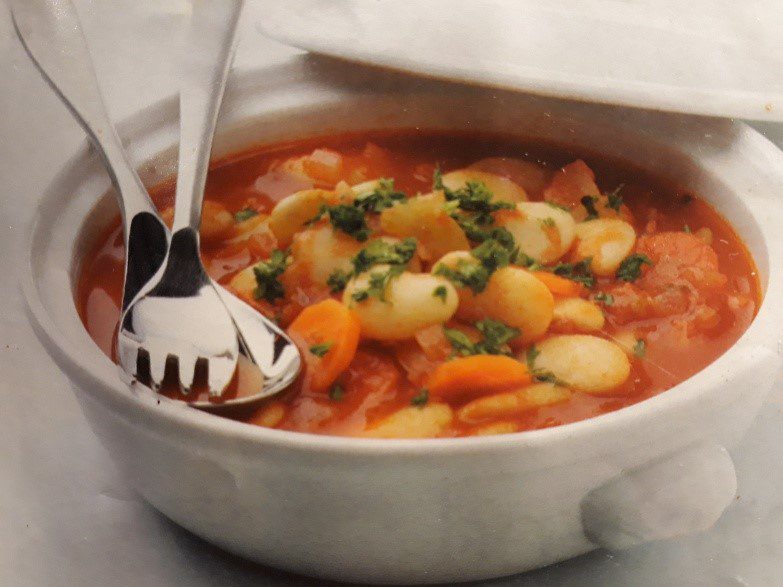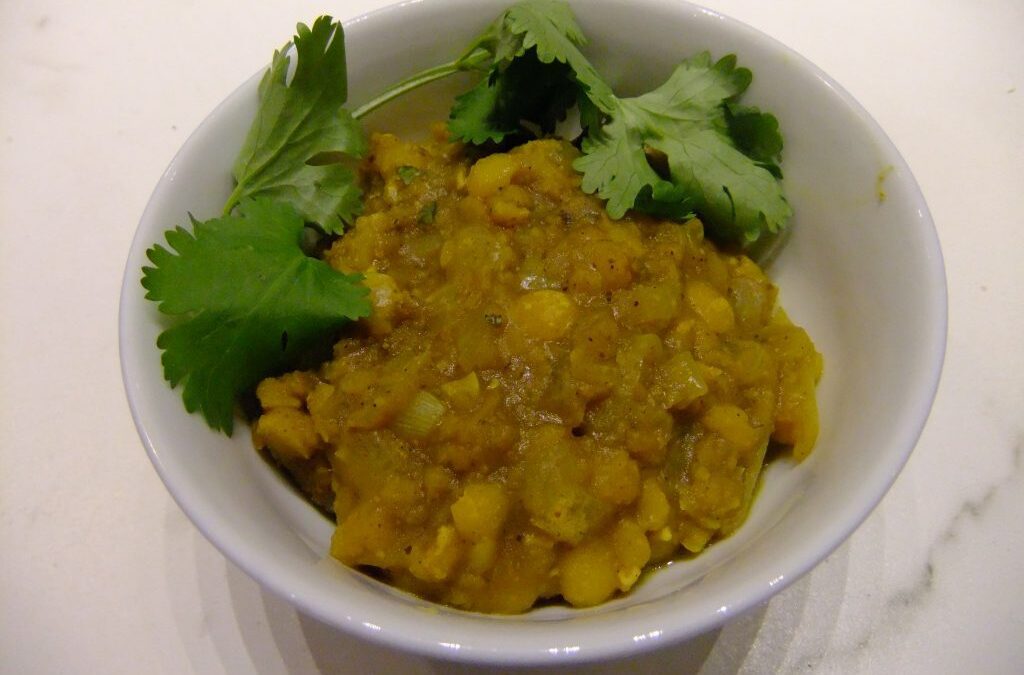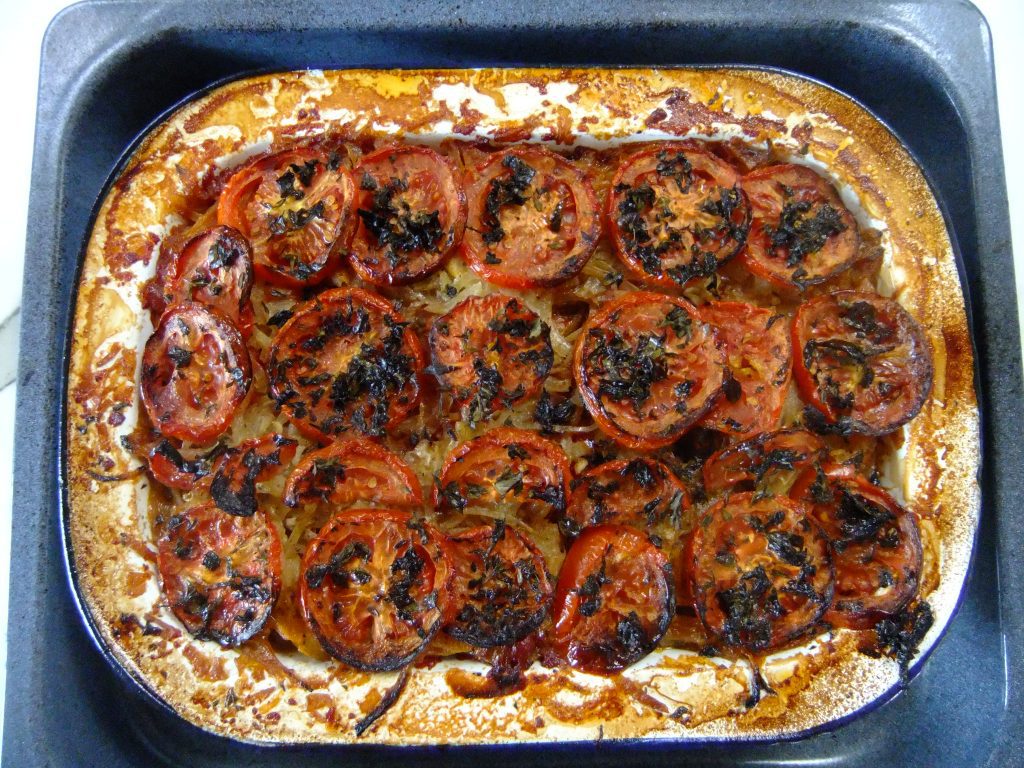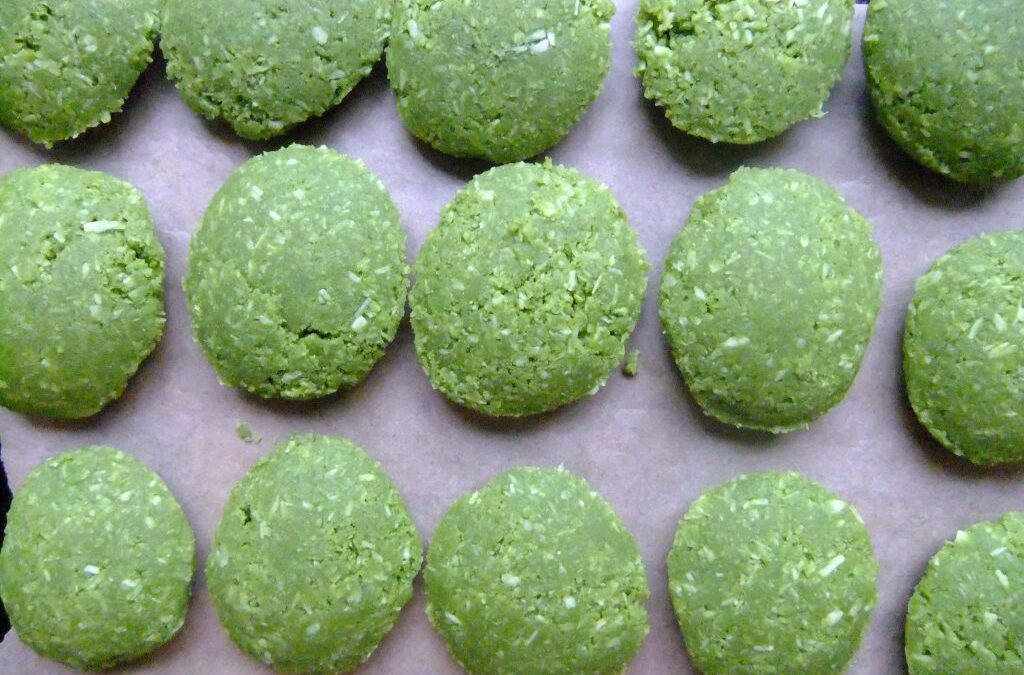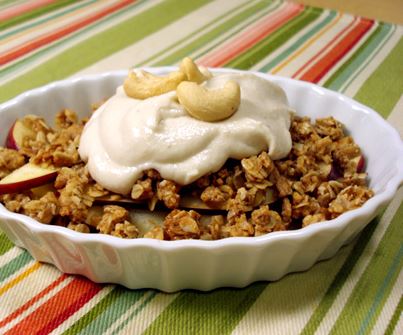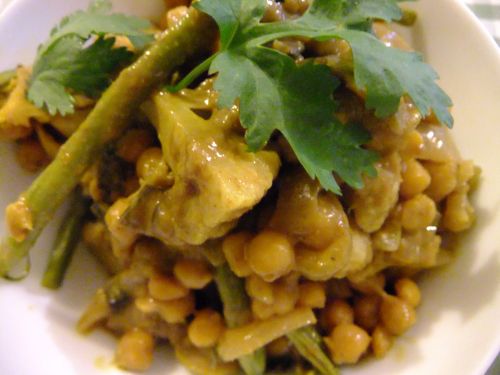
Feb 28, 2019 | Anna's Best Recipes, Main courses
Because I am an indolent cook and destalking thyme is a pain I leave the thyme leaves attached to the sprigs. They usually fall off in the cooking and then you only need to fish out the denuded twigs. I don’t do this with rosemary – the leathery leaves go everywhere and the texture isn’t good – so I chop the rosemary finely.
1 tbs extra virgin olive oil
1 red onion, chopped
2 cloves garlic, crushed or finely chopped
1 mugful of bite size chunks of root veg: choose from Swede or white turnip, Jerusalem artichokes or (for people NOT on SC diet) potato or sweet potato.
1 large carrot, sliced
1 large stick celery, sliced
1 tsp each ground cumin and coriander
½-1 tsp cayenne pepper
400g can butter beans (drained) or soak (overnight) 200g dried butter beans in water and boil til tender.
250 g tomatoes, chopped (fresh or tinned)
Large handful fresh thyme sprigs
6” sprig fresh rosemary, destalked and finely chopped (or you can leave the whole sprig in and then spend ages picking the annoying leathery leaves out when everything’s cooked)
150ml vegetable stock (For SC diet add 1/2 teaspoon additive free Vegetable bouillon powder such as Dr Coy’s to boiling water). If you don’t need SC diet-friendly use Vecon vegetable bouillon powder or Kallo vegetable stock cube.
5 juniper berries, lightly crushed
3 tbs fresh parsley, finely chopped (you can chop and keep in the freezer for easy use)
- Add the oil, onion, garlic, potato/Jerusalem artichoke/turnip, carrot, celery and spices to a heavy bottomed saucepan or casserole, give everything a stir to mix with the oil and spices, put on the lid, and sweat for 5-10 mins until the onion is translucent but not brown. You might need to add a splash of water to stop everything browning.
- Add the cooked beans, tomatoes, thyme sprigs, rosemary, stock, juniper berries, bring to the boil, cover with a lid and gently simmer till the vegetables are cooked.
- Garnish with parsley.
Serve with:
Steamed broccoli or a green salad dressed with a little olive oil and lemon juice
Optional extras (for people NOT on SC Diet) choose one:
Quinoa grains – 11% protein so great with a beany dinner. Its protein keeps added to the bean protein keeps you fuller for longer. Cook in twice its volume of boiling water in a covered saucepan – around 8-10 mins until it looks bobbley.
Brown rice (add a little turmeric to the water before cooking for a lovely golden colour)
Why this is good for you:
Beans are a rich source of magnesium which you need for calm, sleep, clear skin, proper muscle and liver function and much much more. Stress, refined foods (sugar/white grains), alcohol, stimulants and smoking rob magnesium from your body. Millet is also rich in magnesium.
Fresh thyme, rosemary and spices are rich sources of phytochemicals (also called polyphenols or bioflavonoids). These are natural antioxidants many times more powerful than vitamins and minerals. Phytochemicals help reduce inflammation. This helps prevent or relieve conditions like heart disease and any condition with an -itis – arthritis, dermatitis, bursitis etc. It doesn’t help with work-itis, which I used to have in my old job!

Feb 23, 2018 | Anna's Best Recipes, Main courses
This is gorgeous. The tomatoes and apples perfectly balance the earthy flavour of yellow split peas. Like all beans and pulses this is more digestible and cooks faster if you soak the split peas overnight in clean cold water to about twice their depth in a saucepan or bowl. This is even better the next day and freezes really well.For 2 people with 1 serving of leftovers
160g/1 mug dried yellow split peas
1/2 level tsp ground turmeric to add to the cooking water
1 tbs ghee or virgin coconut oil
1 heaped tsp cumin seeds
1 medium onion, finely chopped
1 gently rounded tsp garam masala (available in Asian stores)
1/2 level tsp ground red chilli
1/2 level tsp ground turmeric
400g chopped tomatoes, ideally fresh but canned will do
160g cooking apples, peeled, cored and chopped into 1cm piecesGarnish:
2 tbs chopped fresh coriander1. If using dried split peas: Place the peas with 800ml clean water and the 1/2 tsp turmeric in a heavy-based saucepan and bring to the boil over a medium heat. Skim off any foam. Reduce heat to medium, cover and cook for 25 minutes until tender.
If using soaked split peas: discard the soak water, place the peas and the half teaspoon turmeric in a saucepan with enough clean water to cover by about 2cm. Boil for a few minutes, skimming off any foam before turning down the heat to medium, cover and cook till tender for between 15 and 20 minutes. SOAKED SPLIT PEAS ARE BETTER IF YOU HAVE A SENSITIVE GUT.
2.
Meanwhile heat the ghee or coconut oil in a heavy-based pan on a medium heat, add 1 dsp water along with the onions and cover with a lid. Sweat, stirring occasionally, until the onions are translucent. If its drying out too much before the onions are done, add a little more water to keep it steam-frying rather than browning or burning.
3. Stir in the rounded tsp of garam masala, 1/2 tsp of chilli and 1/2 tsp turmeric. Cook for a minutes, stirring and then add the tomatoes and the apple.
4. cook for about 25 minutes until most of the liquid has been absorbed, the apples are soft and the tomatoes have broken down.
5. Add the cooked split peas and simmer for a few minutes.
6. Garnish with the chopped coriander.Serve with:
Steamed greens (e.g. broccoli, green/runner beans, cabbage, sprouts, pak choi) plus one of the following:
Cauliflower rice
https://www.annacollins.ie/cauliflower-rice/
Indian spiced squash
https://www.annacollins.ie/?s=indian+spiced+squash
Not for SC diet: Brown rice or quinoa
Why this is good for you
This has a range of fibres that feed different categories of good gut bacteria, all of which you need to remain well. Pectin from the cooking apples, inulin from the onions, soluble fibre from the split peas all feed good bacteria. Cumin and garam masala have a suppressing effect on “bad”, pro-inflammatory bacteria in your gut. I always recommend a wide variety of plant types and herbs and spices to people who want to optimise their health and get digestive, bowel or autoimmune issues into remission. And guess what – stewed cooking apple in this recipe helps lower bowel inflammation too.

Aug 31, 2016 | Anna's Best Recipes, Main courses, Sides, starters, soups & snacks
This is delicious hot, lukewarm or cold. I also like to mix leftovers with cooked quinoa to take to work. People living on the Greek island of Ikaria have the secret of healthy longevity. This is one of their recipes, which I found in the Irish Times recently. We can’t get giant white beans here but butter beans work really well. I wasn’t sure it would turn out well, but it was delicious – very intense flavours. It contains a lot of liquid. So make sure to use a large dish, otherwise it can boil over in the oven (like it did on me). Slicing the carrots very thinly is a bit of a fiddly chore unless you use a mandolin or a food processor. If you can’t face it or don’t own a decent knife: slice about 1/2 cm thick, steam for a few minutes to soften (keeping the water to make the veg stock with so you don’t lose flavour or nutrients). If you put thick sliced raw carrots into the dish they will still be raw when everything else is starting to burn! Yummy though. This also works well as a side dish with, say, roast lamb.
For 4:
6 tbsp extra virgin olive oil
1 x 640g jar of passata (sieved tomatoes)
2 x 400g tins butter beans, drained (or soak 400g or 2 cups dried beans overnight and boil till tender)
3 onions, finely sliced
4 garlic cloves, finely sliced
4 carrots, thinly sliced
2 large beef (or 4 regular) tomatoes, sliced
A good handful of fresh oregano (if you can’t get it, use 1 dsp dried)
A few sprigs of thyme
2 bay leaves
300ml vegetable stock
Sea salt and ground black pepper
- Preheat an oven to 220 degrees (205C fan).
- Add the onions and garlic to a bowl with four tablespoons of olive oil. Season with sea salt and ground black pepper. Massage the onions until they begin to soften down.
- Arrange the butter beans in the base of a large earthenware or baking dish. Place carrots on top.
- Pour over the passata and spread evenly. Arrange the onion mixture across the top, then the tomato slices and press the herbs on top.
- Pour over the vegetable stock, drizzle on the remaining oil and season. Bake on the middle shelf for 40 minutes or until the point of a knife or cooking skewer goes through the carrots easily.
Serve warm, lukewarm or cool with a green salad on the side. You can use leftovers as an accompaniment to grilled or baked white fish. Or (provided you’re not on SC Diet) stir into cooked quinoa to make a quick lunch (or packed lunch).
Why this is good for you:
Butter beans, onions and garlic give you soluble fibre which feeds good gut bacteria needed to help you get rid of toxins, have happier mood (yes, gut bacteria make the feel-good brain chemical serotonin!) and a healthier immune system. A healthy immune system is one that doesn’t over react causing autoimmunity (e.g. rheumatoid arthritis, hypothyroidism). Nor does it under react causing lowered resistence to viral, bacterial or fungal infections. Lycopene in tomatoes is fantastic for supporting vision and so are carrots with their various carotenoids. Lycopene and carotenoids are antioxidants – they protect you from damage.

Aug 17, 2014 | Anna's Best Recipes, Cakes, biscuits & bars
These are a simple-to-make confection from Sarah Jane White, whose book, The Extra Virgin Kitchen, is a favourite of mine. I made them today and they turned out a totally delicious treat that’s bright green. As the author says, they are idiot-proof. Although you are supposed to freeze them I didn’t bother and just chilled them down to harden them a bit. Yum!
If you are gluten-free, remember that vanilla “essence” can contain gluten while vanilla extract (made from actual vanilla) is gluten-free.
Buy matcha green tea powder in Asian shops or health stores.
Makes 16
1 teaspoon vanilla extract (or a generous pinch of vanilla powder)
3 level teaspoons matcha green tea powder
125g desiccated coconut
2 tbs coconut flour
Pinch sea salt/Himalayan salt
3 rounded tbs coconut oil
2-4 level tbs honey
Pinch dried ground turmeric
Quick squeeze fresh lemon juice (2 dessertspoons, give or take)
Food processor
Line a flat plate or baking sheet with greaseproof paper.
Add the ingredients to the food processor and blitz for 30 seconds, or until the mix starts to form a ball.
The next thing you want to do is shape the dough using 2 dessertspoons or small soup spoons. Scoop out a small spoonful of dough and form it into a mini macaroon or madeleine shape using both spoons. As Sarah Jane suggests, you could also use one of those special metric tablespoon you can buy from kitchen suppliers, to give a professional looking shape.
Freeze the macaroons until they are solid, then transfer to your fridge.
Why these are good for you:
Green tea has health benefits as they are laden with antioxidant catechins. Green tea promotes the growth of beneficial bacteria in your gut which are helpful for clear skin, super-efficient digestion and absorption of nutrients. Good bacteria are also responsible for helping remove toxic chemicals and used-up hormones from your body quickly and safely. Green tea also contains L-theanine, an amino acid that can be super-helpful for reducing stress or anxiety. Coconut oil is a great source of medium chain triglycerides. These help feed your brain and also supply ready energy to your body without being converted to fat! Lemon juice has antioxidant properties and helps boost liver function, to help rid you of all those natural and man-made toxins your body works to get rid of every minute of every hour.

Dec 19, 2013 | Anna's Best Recipes, Desserts & drinks, Dressings, rubs, spreads, sauces & more
I love this with Christmas pud or mince pies. This is a brilliant substitute for dairy cream and is naturally sweet. You want a mini food processor or a spice/coffee grinder to make this easily. I think these 2 gadgets are the best pieces of kit you can get for your kitchen if you want to eat lots of easy-to-prepare interesting and healthy food. Alternatively a mortar and pestle and a lot of effort would work. This “cream” keeps for at least 3 days in the fridge, covered. If it dries out a bit, just add a little water and mix well to smooth it out.
3 servings
½ cup unsalted unroasted cashew nuts
1 cup filtered water
A few drops of vanilla extract
Grinder or pestle-and-mortar method (for an even smoother consistency):
- Do not soak the cashews but grind finely, then beat in the water and vanilla essence with a whisk.
- If you want it thinner add more water, thicker add more ground nuts.
Mini food processor method:
- Soak cashew nuts overnight in the cup of filtered water
- Blitz all ingredients in a miniature food processor until it reaches a creamy consistency. Add more water to thin if you like.
Tip: You can make a similar “cream” using soaked and peeled almonds.
Why this is good for you:
Cashew nuts contain some protein and beneficial fats which help balance blood sugar, reducing the tendency to binge eat.. This is particularly great if you are serving with mince pies, plum pud or other high carb foods. Cashews are also rich in magnesium, which helps keep mood chilled, spirits high, blood pressure normal and much much more. People need lots of magnesium-rich foods at Christmas, when alcohol, white flour and sugar deplete this nutrient.

Dec 16, 2013 | Anna's Best Recipes, Cakes, biscuits & bars, Desserts & drinks
This is a delicious, short, sweetish pastry. I used it to make mince pies this week and they were fantastic. Your have to be careful though that they don’t burn. Placing a baking sheet above the pies on the next shelf of the oven (about an inch above the top of the pies) is the best way to prevent burning. The crust will be quite thick as its tricky to roll out without breaking. If you have a food processor, use it to make the pastry. It’s a doddle!
Makes 9 mince pies, with covers
100g finely ground almonds (or raw hazelnuts instead, ground finely in your spice grinder or mini food processor)
65g gluten-free oat flour from health stores (or make your own in a food processor/grinder using GF oatflakes). If you’re not coeliac or gluten-sensitive, normal oat flour is fine.
A little extra oat flour or brown rice flour for rolling out the pastry
1 level teaspoon xanthan gum
25g virgin coconut oil
1 dsp virgin macadamia oil or light olive oil
1 level dsp honey (use a hot spoon and a knife to measure)
1½ – 2 tbs iced water
Patty tin
A metal baking sheet
Pastry cutters, ideally a 7.5cm circular one and a star shape (or 5.5cm circular one)
A jar of my home-made mincemeat (recipe posted separately)
- Combine ground almonds, xanthan gum and oat flour and mix well. Rub in the coconut oil (you can do this in a food processor if you want) until the mix looks like breadcrumbs. Add the macadamia/light olive oil, the honey, and the iced water and blend again.
- Roll out the pastry on a board floured with rice or GF oat flour.
- Grease your patty tins with a little coconut oil. Cut out pastry circles to fit and line the tins with these.
- Add about a heaped tsp mincemeat (or a little more) per pie. Press together and roll out the pastry remnants. Cut out smaller circles or star shapes and top the pies with these. There’s no need to seal the edges, just press the tops down lightly to flatten a little.
- Bake at 200C/185C fan with a metal baking sheet placed just above the pies, on the next rack of the oven, for about 15 minutes. The baking sheet above the pies reduces burning. If they are getting too brown, remove from the oven, otherwise leave in for another 5 minutes.
- If you choose to use my crumble topping for mince pies instead of using pastry covers, bake at 180c/165 fan oven so the almond flakes dont burn.
Why this is better for you:
So what’s the difference between oats and gluten-free oats? Oats are usually contaminated with gluten grains like wheat and barley because they are harvested in the same hoppers and crops may be rotated. Gluten-free oats are grown and harvested completely seperately from gluten grains. They are batch tested for purity and that’s why they can be certified gluten-free.
The pastry in these pies uses mostly healthy oils that are good for health and vitality. Coconut oil in particular, is safe, even when heated to 200C. That means it won’t contribute to excessive ageing, skin breakouts, or weight gain. The special fats (medium chain triglycerides) contained in coconut oil are burned directly by your body instead of being stored as fat. Good news for Christmas waistlines! Oats are of course a wholegrain and are rich in chromium and fibre. This, and the protein content of the almonds, helps regulate blood sugar levels, keeping your mood and energy more stable. Almonds contain magnesium which is important for a happy, stress-free mood. That said, cooking any nuts or ground nuts damages their healthy oils so this is not an everyday recipe, but a occasional treat recipe.

Nov 8, 2013 | Anna's Best Recipes, Main courses
This recipe comes from Food Glorious Food, by Patrick Holford and Fiona McDonald Joyce. I did adapt the quantities slightly, increasing the chickpeas, giving more protein to keep you fuller for longer. We also used curry powder instead of the curry paste recommended and it was still lovely. It isn’t hot. The curry is really a meal in itself without needing accompaniments though we did roast some pumpkin wedges. We coated them in tomato puree and spices according to Patrick and Fiona’s recipe for Indian Spiced butternut squash, also from the same book. Don’t be tempted to leave out the coconut oil – extra (healthy) oils are very important for keeping you fuller longer when you eat animal-free meals.
For 3 big eaters, with a little left for lunch next day:
Remember to go to my “larder & shopping” section for unusual ingredients.
2 tbsp extra virgin coconut oil
2 heaped tbs Thai curry paste or Sharwoods Madras curry powder (or any curry powder – make sure to check labels for gluten if relevant)
2 large onions, sliced
2/3 large cauliflower, broken into bite size florets
2 x 400g tins chickpeas or 220g dried chickpeas, soaked overnight, then boiled till tender to yield 440g when cooked and drained (about 2 mugs)
400ml can full fat coconut milk
100ml hot vegetable stock (use 1/4 teaspoon Marigold bouillon or 1/2 a Kallo vegetable stock cube to make this up)
1 tbs tamari sauce
250g fine green beans (or you could use runner beans, cut into 2″ lengths)
Optional: Handful of coriander, torn or roughly chopped
- Put the oil, curry powder and onions in a large heavy-bottomed saucepan or Le Creuset type pot on a medium heat, mix around, cover with a lid or plate and sweat until softened and translucent – this usually takes around 10 minutes. Add the cauliflower and chickpeas to the pan and stir to coat them in the other ingredients.
- Pour in the coconut milk, stock and tamari, and stir. Bring to the boil, then cover and simmer over a gentle heat until the cauliflower is nearly done. I found this took about 15 minutes.
- Stir in the green beans, cover and cook for another 5 minutes or so until they’re tender. Scatter with the coriander leaves (if using) before serving.
To serve: You can eat this curry on its own, or serve with brown rice or with the gorgeous Indian spiced butternut squash recipe I will be posting shortly.
Why this recipe is good for you:
Thousands of clinical studies show that a wide range of spices have profoundly anti-inflammatory properties, helping soothe joints, digestive system and delay ageing. Sometimes people complain that Indian takeaways upset them, thinking it is the spices. It is more likely to be the heavy use of low quality refined oils that promote inflammation and play havoc with their stomachs!! The chickpeas in this recipe are a good source of protein and also of soluble fibre, that feeds beneficial bacteria in the gut to help your health. Chickpeas, like all beans and pulses, need to be soaked and boiled thoroughl (or tinned!) to make them digestible. Virgin coconut oil and full fat coconut milk contain important medium chain triglyceride fats that feed your brain. MCTs also used by the body directly to make energy, rather than being stored as fat – good news if you want to be slim and trim. People with ME/chronic fatigue syndrome particularly benefit from coconut oil in their diets. Cauliflower is a sulphurophane vegetable, helping your liver detoxify used-up hormones and other waste products. Substituting beans/pulses for meat/cheese in some of your meals every week is a good way of helping your kidney function and supporting joint and bone health. Fresh coriander binds to heavy metals such as mercury and aluminium in the gut, helping their safe elimination. “Silver” fillings give off toxic mercury while “normal” tea is high in aluminium, a known neurotoxin. Helping your body eliminate these is good news.
